Lunar Gateway
The Lunar Gateway is a planned space station in lunar orbit intended to serve as a solar-powered communication hub, science laboratory, short-term habitation module, and holding area for rovers and other robots.[4] It is expected to play a major role in NASA's Artemis program, after 2024. While the project is led by NASA, the Gateway is meant to be developed, serviced, and utilized in collaboration with commercial and international partners: Canada (CSA), Europe (ESA), and Japan (JAXA). It will serve as the staging point for both robotic and crewed exploration of the lunar south pole, and is the proposed staging point for NASA's Deep Space Transport concept for transport to Mars.[5][6][7] Formerly known as the Deep Space Gateway (DSG), the station was renamed Lunar Orbital Platform-Gateway (LOP-G) in NASA's 2018 proposal for the 2019 United States federal budget.[8][9] When the budgeting process was complete, US$332 million had been committed by Congress to preliminary studies.[10][11][12]
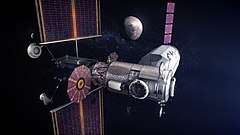 Concept art of the Gateway as it is intended to appear in 2024; the PPE and HALO modules are visible with a cargo spacecraft docked. | |
| Station statistics | |
|---|---|
| Crew | 4 (planned) |
| Launch | 2024 (planned) [1] |
| Carrier rocket | SpaceX Falcon Heavy, or ULA Vulcan Centaur, or Blue Origin New Glenn |
| Launch pad | Kennedy Space Center |
| Mission status | Modules in development: PPE HALO |
| Pressurised volume | Planned: ≥125 m3 (4,400 cu ft)[2] |
| Pericynthion altitude | 3,000 kilometres (1,900 mi)[3] |
| Apocynthion altitude | 70,000 kilometres (43,000 mi)[3] |
| Orbital inclination | Polar near-rectilinear halo orbit (NRHO)[3] |
| Orbital period | ≈7 days[3] |
| Configuration | |
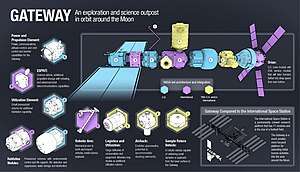 Although not the final configuration, this infographic shows the current lineup of parts comprising the Gateway.
US modules
International modules
US and/or international modules | |
The science disciplines to be studied on the Gateway are expected to include planetary science, astrophysics, Earth observations, heliophysics, fundamental space biology, and human health and performance.[13] Gateway development includes all of the International Space Station partners: ESA, NASA, Roscosmos, JAXA, and CSA. Construction is planned to take place in the 2020s.[6][14][15] The International Space Exploration Coordination Group (ISECG), which is composed of more than 14 space agencies including all major ones, has concluded that Gateway will be critical in expanding a human presence to the Moon, Mars, and deeper into the Solar System.[16]
Name and logo
The Gateway is with its name and logo associated with the American frontier symbol of the St. Louis Gateway Arch.[17]
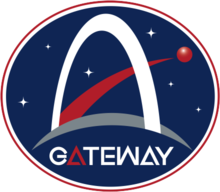
History
Studies
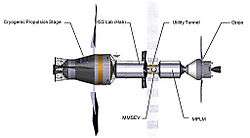
An earlier NASA proposal for a cislunar station had been made public in 2012 and was dubbed the Deep Space Habitat. That proposal had led to funding in 2015 under the NextSTEP program to study the requirements of deep space habitats.[18] In February 2018, it was announced that the NextSTEP studies and other ISS partner studies would help to guide the capabilities required of the Gateway's habitation modules.[19] On 27 September 2017, an informal joint statement on cooperation between NASA and Russia's Roscosmos was announced.[15] The solar electric Power and Propulsion Element (PPE) of the Gateway was originally a part of the now-canceled Asteroid Redirect Mission.[20][21] On 7 November 2017, NASA asked the global science community to submit concepts for scientific studies that could take advantage of the Deep Space Gateway's location in cislunar space.[13] The Deep Space Gateway Concept Science Workshop was held in Denver, Colorado from 27 February to 1 March 2018. This three-day conference was a workshop where 196 presentations were given for possible scientific studies that could be advanced through the use of the Gateway.[22]
In 2018, NASA initiated a Revolutionary Aerospace Systems Concepts Academic Linkage (RASC-AL) competition for universities to develop concepts and capabilities for the Gateway. The competitors are asked to employ original engineering and analysis in one of four areas; "Gateway Uncrewed Utilization and Operations", "Gateway-Based Human Lunar Surface Access", "Gateway Logistics as a Science Platform", and "Design of a Gateway-Based Cislunar Tug". Teams of undergraduate and graduate students were asked to submit a response by 17 January 2019 addressing one of these four themes. NASA will select 20 teams to continue developing proposed concepts. Fourteen of the teams presented their projects in person in June 2019 at the RASC-AL Forum in Cocoa Beach, Florida, receiving a US$6,000 stipend to participate in the Forum.[4] "Lunar Exploration and Access to Polar Regions" from the University of Puerto Rico at Mayagüez was the winning concept.[23]
Power and propulsion
On 1 November 2017, NASA commissioned 5 studies lasting four months into affordable ways to develop the Power and Propulsion Element (PPE), hopefully leveraging private companies' plans. These studies had a combined budget of $2.4 million. The companies performing the PPE studies were Boeing, Lockheed Martin, Orbital ATK, Sierra Nevada and Space Systems/Loral.[24][21] These awards are in addition to the ongoing set of NextSTEP-2 awards made in 2016 to study development and make ground prototypes of habitat modules that could be used on the Gateway as well as other commercial applications,[7] so the Gateway is likely to incorporate components developed under NextSTEP as well.[21][25] NASA officials stated that the most likely ion engine to be used on the PPE is the 14 kW Hall thruster called Advanced Electric Propulsion System (AEPS) which has an Isp of up to 2,600 s (25 km/s). The engine is being developed by Glenn Research Center, the Jet Propulsion Laboratory, and Aerojet Rocketdyne.[26] Four identical AEPS engines would consume the 50 kW generated.[26] In 2019, the contract to manufacture the PPE was awarded to a division of Maxar Technologies (formerly SSL).[27] After a one-year demonstration period, NASA would then "exercise a contract option to take over control of the spacecraft".[28] Its expected service time is about 15 years.[29]
Orbit and operations
The Gateway is planned to be deployed in a highly elliptical seven-day near-rectilinear halo orbit (NRHO) around the Moon, which would bring the station within 3,000 kilometres (1,900 mi) of the lunar north pole at closest approach and as far away as 70,000 kilometres (43,000 mi) over the lunar south pole.[3][30][31] Traveling to and from cislunar space (lunar orbit) is intended to develop the knowledge and experience necessary to venture beyond the Moon and into deep space. The proposed NRHO orbit would allow lunar expeditions from the Gateway to reach a low polar orbit with a delta-v of 730 m/s and a half a day of transit time. Orbital station-keeping would require less than 10 m/s of delta-v per year, and the orbital inclination could be shifted with a relatively small delta-v expenditure, allowing access to most of the lunar surface. Spacecraft launched from Earth would perform a powered flyby of the Moon (delta-v=~180 m/s) followed by a ~240 m/s delta-v NRHO orbit insertion burn to dock with the Gateway as it approaches the apoapsis point of its orbit. The total travel time would be 5 days; the return to Earth would be similar in terms of trip duration and delta-v requirement if the spacecraft spends 11 days at the Gateway. The crewed mission duration of 21 days and ~840 m/s delta-v are limited by the capabilities of the Orion life support and propulsion systems.[32]
One of the advantages of a NRHO orbit is the minimal amount of communications blackout with the Earth.
Gateway will be the first mini-space station to be both human-rated, and autonomously operating most of the time in its early years, as well as being the first deep-space station, far from Low Earth orbit. This will be enabled by more sophisticated executive control software than on any prior space station, which will monitor and control all systems. The high-level architecture is provided by the Robotics and Intelligence for Human Spaceflight lab at NASA, and implemented at NASA facilities. The Gateway could conceivably also support in-situ resource utilization (ISRU) development and testing from lunar and asteroid sources,[33] and would offer the opportunity for gradual buildup of capabilities for more complex missions over time.[34]
Structure
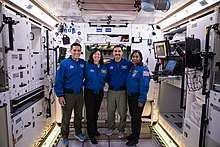
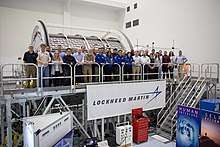
For supporting the first crewed mission to the station (Artemis 3) planned for 2024, the Gateway will be a minimalistic mini-space station composed of only two modules: the Power and Propulsion Element (PPE) and the Habitation and Logistics Outpost (HALO).[35][36] Various components of the Gateway were originally planned to be assembled using the Space Launch System (SLS) as co-manifested flights with the Orion spacecraft,[37] but will now be launched on commercial launch vehicles.[38] According to Roscosmos, they may also use Proton-M and Angara-A5M heavy launchers to fly payloads or crew;[15] however, this is no longer on the agenda.[39] All modules will be connected using the International Docking System Standard.[40] Both PPE and HALO will be assembled on Earth and launched together with a single launcher in November 2023 and they are expected to reach lunar orbit after nine to ten months.[41] The Canadian Space Agency, the European Space Agency and the Japan Aerospace Exploration Agency plan to participate in the Gateway project, contributing a robotic arm, refueling and communications hardware, and habitation and research capacity. Those international elements will launch after the PPE and HALO are placed into lunar orbit.[42]
| Cargo docking port | |||||||||||||||||||||||||
| Solar array | ESPRIT service module | ||||||||||||||||||||||||
| PPE propulsion module | HALO logistics and habitat | Orion docking port | |||||||||||||||||||||||
| Solar array | HLS docking port | ||||||||||||||||||||||||
Planned modules
- The Power and Propulsion Element (PPE) started development at the Jet Propulsion Laboratory during the now canceled Asteroid Redirect Mission. The original concept was a robotic, high performance solar electric spacecraft that would retrieve a multi-ton boulder from an asteroid and bring it to lunar orbit for study.[43] When ARM was cancelled, the solar electric propulsion was repurposed for the Gateway.[44][45] The PPE will allow access to the entire lunar surface and act as a space tug for visiting craft.[27] It will also serve as the command and communications center of the Gateway.[46][47] The PPE is intended to have a mass of 8-9 tons and the capability to generate 50 kW[21] of solar electric power for its ion thrusters, which can be supplemented by chemical propulsion.[48] It is currently planned to launch on a commercial launch vehicle in November 2023 with HALO module.[49][50][51][52] In May 2019, Maxar Technologies was contracted by NASA to manufacture this module, which will also supply the station with electrical power and is based on Maxar's 1300 series satellite bus. The PPE will use Advanced Electric Propulsion System (AEPS) Hall-effect thrusters.[53][54] Maxar was awarded a firm-fixed price contract of $375 million to build the PPE. NASA is supplying the PPE with an S-band communications system to provide a radio link with nearby vehicles and a passive docking adapter to receive the Gateway's future utilization module.[55]
- The Habitation and Logistics Outpost (HALO),[56][57] also called the Minimal Habitation Module (MHM) and formerly known as the Utilization Module,[58] will be built by Northrop Grumman Innovation Systems (NGIS).[35][59] A commercial launch vehicle will launch the HALO in November 2023 with the PPE module.[49][50] The HALO is based directly on a Cygnus Cargo resupply module[35][60] to the outside of which radial docking ports, body mounted radiators (BMRs), batteries and communications antennae will be added. The HALO will be a scaled-down habitation module,[61] yet it will feature a functional pressurized volume providing sufficient command, control and data handling capabilities, energy storage and power distribution, thermal control, communications and tracking capabilities, two axial and up to two radial docking ports, stowage volume, environmental control and life support systems to augment the Orion spacecraft and support a crew of four for at least 30 days.[59] On 5 June 2020, Northrop Grumman Innovation Systems was awarded a contract, by NASA, of $187 million to complete the preliminary design of HALO. NASA will sign a separate contract with Northrop for the fabrication of the HALO, and for integration with the PPE, being built by Maxar.[62]
- The European System Providing Refueling, Infrastructure and Telecommunications (ESPRIT) service module will provide additional xenon and hydrazine capacity, additional communications equipment, and an airlock for science packages, in 2025.[2] It will have a mass of approximately 4,000 kg (8,800 lb), and a length of 3.91 m (12.8 ft).[63] ESA has awarded two parallel design studies one mostly led by Airbus in partnership with Comex and OHB[64] and one led by Thales Alenia Space[65] The construction of the module was approved in November 2019.[66][67]
Proposed modules
The concept for the Gateway is still evolving, and is intended to include the following modules:[68]
- The International Habitation Module (iHAB) will be an additional habitation module built by ESA in collaboration with Japan.[66] Together with the HALO module, they will provide a combined 125 m3 (4,400 cu ft) of habitable volume to the station, after 2024.[2]
- The Gateway Logistics Modules will be used to refuel, resupply and provide logistics on board the mini-space station. The first logistics module sent to the Gateway will also arrive with a robotic arm, which will be built by the Canadian Space Agency.[69][70]
- The Gateway Airlock Module will be used for performing extravehicular activities outside the mini-space station and would have the docking port for the proposed Deep Space Transport.
Construction
Crewed flights to the Gateway are expected to use Orion and SLS, while other missions are expected to be done by commercial launch providers. In March 2020, NASA announced SpaceX with its future spacecraft Dragon XL as a first commercial partner to deliver supplies to the Gateway.[71] The 2 modules (PPE and HALO) will be launched together on a single launcher in November 2023.[50]
| Year | Mission objective | Mission name | Launch vehicle | Human/robotic elements |
|---|---|---|---|---|
| November 2023 [72] | Launch of the Power and Propulsion Element (PPE)[73] | Mini-space station Gateway | Commercial launch vehicle [72] | Robotic |
| November 2023 [74][75] | Launch of the Habitation, and Logistics Outpost (HALO) to the Gateway | Mini-space station Gateway | Commercial launch vehicle [74] | Robotic |
| 2024 | Delivery of expendable ascent element for Artemis 3 | Artemis support mission | Commercial launch vehicles | Robotic |
| 2024 | Delivery of expendable transfer element for Artemis 3 | Artemis support mission | Commercial launch vehicles | Robotic |
| 2024 | Delivery of expendable descent element for Artemis 3 | Artemis support mission | Commercial launch vehicles | Robotic |
| 2024 | Delivery of Orion MPCV and logistics module | Artemis 3 | SLS Block 1 | Crewed |
| 2025 | (Proposed) delivery of expendable ascent element for Artemis 4 | Artemis support mission | Commercial launch vehicles | Robotic |
| 2025 | (Proposed) delivery of expendable descent element for Artemis 4 | Artemis support mission | Commercial launch vehicles | Robotic |
| 2025 | (Proposed) delivery of expendable transfer element for Artemis 4 | Artemis support mission | Commercial launch vehicles | Robotic |
| 2025 | (Proposed) Delivery of Orion MPCV and logistics module | Artemis 4 | SLS Block 1B | Crewed |
| 2026 | Delivery of iHAB to the Gateway | Artemis support mission | Commercial launch vehicles | Robotic |
| 2026 | (Proposed) delivery of reusable ascent element for Artemis 5 | Artemis support mission | Commercial launch vehicles | Robotic |
| 2026 | (Proposed) delivery of reusable transfer element for Artemis 5 | Artemis support mission | Commercial launch vehicles | Robotic |
| 2026 | (Proposed) delivery of descent element for Artemis 5 | Artemis support mission | Commercial launch vehicles | Robotic |
| 2026 | (Proposed) Delivery of Orion MPCV and logistics module | Artemis 5 | SLS Block 1B | Crewed |
| 2027 | (Proposed) delivery of a Gateway station module | Artemis support mission | Commercial launch vehicles | Robotic |
| 2027 | (Proposed) refueling of ascent element for Artemis 6 | Artemis support mission | Commercial launch vehicles | Robotic |
| 2027 | (Proposed) refueling of transfer element for Artemis 6 | Artemis support mission | Commercial launch vehicles | Robotic |
| 2027 | (Proposed) delivery of descent module for Artemis 6 | Artemis support mission | Commercial launch vehicles | Robotic |
| 2027 | (Proposed) Delivery of Orion MPCV and logistics module | Artemis 6 | SLS Block 1B | Crewed |
| 2028 | (Proposed) delivery of a Gateway station module | Artemis support mission | Commercial launch vehicles | Robotic |
| 2028 | (Proposed) refueling of ascent element for Artemis 7 | Artemis support mission | Commercial launch vehicles | Robotic |
| 2028 | (Proposed) refueling of transfer element for Artemis 7 | Artemis support mission | Commercial launch vehicles | Robotic |
| 2028 | (Proposed) delivery of descent module for Artemis 7 | Artemis support mission | Commercial launch vehicles | Robotic |
| 2028 | (Proposed) Delivery of Orion MPCV and logistics module | Artemis 7 | SLS Block 1B | Crewed |
Reactions
NASA officials promote the Gateway as a "reusable command module" that could direct activities on the lunar surface.[76] However, the Gateway has received criticisms from several space professionals.
Michael D. Griffin, a former NASA administrator, said that the Gateway could be useful only after there are facilities on the Moon producing propellant that could be transported to the Gateway. Griffin thinks that after that is achieved, the Gateway would then serve as a fuel depot.[76]
Former NASA Associate Administrator Doug Cooke wrote in an article on The Hill stating, "NASA can significantly increase speed, simplicity, cost and probability of mission success by deferring Gateway, leveraging SLS, and reducing critical mission operations". He also wrote, "NASA should launch the lander elements (ascent and descent/transfer) on a SLS Block 1B. If an independent transfer element is required, it can be launched on a commercial launcher".[77] George Abbey, a former director of NASA's Johnson Space Center said, "The Gateway is, in essence, building a space station to orbit a natural space station, namely the Moon. [...] If we are going to return the Moon, we should go directly there, not build a space station to orbit it".[78]
Former NASA astronaut Terry W. Virts, who was a pilot of STS-130 aboard Space Shuttle Endeavour and commander of the ISS on Expedition 43, wrote in an Op-ed on Ars Technica that the Gateway would "shackle human exploration, not enable it". He also said, "If we don't have the goal [of Gateway], we are putting the proverbial chicken before the egg by developing "Gemini" before we know what "Apollo" will look like. Regardless of a future destination, as someone who lived on the ISS for 200 days, I cannot envision a new technology that would be developed or validated by building another modular space station. Without a specific goal, we're unlikely to ever identify one". Terry further criticized NASA for abandoning its planned goal of separating crew from cargo, which was put in place following the Space Shuttle Columbia disaster in 2003.[79] Apollo 11 astronaut Buzz Aldrin stated that he is "quite opposed to the Gateway" and that "using the Gateway as a staging area for robotic or human missions to the lunar surface is absurd". Aldrin also questioned the benefit of the idea to "send a crew to an intermediate point in space, pick up a lander there and go down". On the other hand, Aldrin expressed support for Robert Zubrin's Moon Direct concept which involves lunar landers traveling from Earth orbit to the lunar surface and back.[80]
Pei Zhaoyu, deputy director of the Lunar Exploration and Space Program Center of the China National Space Administration, concluded that, from a cost-benefit standpoint, the Gateway would have "lost cost-effectiveness".[81] Pei said the Chinese plan is to focus on a research station on the surface.[82]
Mars advocacy and Mars Society founder Robert Zubrin called the Gateway "NASA's worst plan yet" in an article in the National Review. He said, "We do not need a lunar-orbiting station to go to the Moon. We do not need such a station to go to Mars. We do not need it to go to near-Earth asteroids. We do not need it to go anywhere. Nor can we accomplish anything in such a station that we cannot do in the Earth-orbiting International Space Station, except to expose human subjects to irradiation – a form of medical research for which a number of Nazi doctors were hanged at Nuremberg". Zubrin also stated, "If the goal is to build a Moon base, it should be built on the surface of the Moon. That is where the science is, that is where the shielding material is, and that is where the resources to make propellant and other useful things are to be found".[83]
Retired aerospace engineer Gerald Black stated that the Gateway is "useless for supporting human return to the lunar surface and a lunar base". He added that it was not planned to be used as a rocket fuel depot and that stopping at the Gateway on the way to or from the Moon would serve no useful purpose and cost propellant.[84]
Mark Whittington, who is a contributor to The Hill newspaper and an author of several space exploration studies, stated in an article that the "lunar orbit project doesn't help us get back to the Moon". Whittington also pointed out that a lunar orbiting space station was not utilized during the Apollo program and that a "reusable lunar lander could be refueled from a depot on the lunar surface and left in a parking orbit between missions without the need for a big, complex space station."[85]
Astrophysicist Ethan Siegel wrote an article in Forbes titled "NASA's Idea For A Space Station In Lunar Orbit Takes Humanity Nowhere". Siegel stated that "Orbiting the Moon represents barely incremental progress; the only scientific "advantages" to being in lunar orbit as opposed to low Earth orbit are twofold: 1. You're outside of the Van Allen belts. 2. You're closer to the lunar surface", reducing the time delay. His final opinion was that the Gateway is "a great way to spend a great deal of money, advancing science and humanity in no appreciable way".[86]
On 10 December 2018, NASA Administrator Jim Bridenstine said at a presentation "There are people who say we need to get there, and we need to get there tomorrow", speaking of a crewed mission to the Moon, countering with "What we're doing here at NASA is following Space Policy Directive 1", speaking of the Gateway and following up with "I would argue that we got there in 1969. That race is over, and we won. The time now is to build a sustainable, reusable architecture. [...] The next time we go to the moon, we're going to have American boots on the moon with the American flag on their shoulders, and they're going to be standing side-by-side with our international partners who have never been to the moon before".[87]
Dan Hartman, the program manager for Gateway, on 30 March 2020, told Ars Technica that the benefits of using Gateway are extending the mission duration, buying down risk, providing research capability and the capability to re-use ascent modules. "When you go single, I'll say direct mission to the Moon, you're limited on the supplies, either with the Lander or with Orion. With the Gateway, with just with one logistics module, we think we can extend to about twice the mission duration, so 30 days to 60 days. Obviously, the more crew time you have in lunar orbit helps us with research in the human aspects of living in deep space. The more duration we have, certainly that'll help us buy down significant risk with the extreme environments that we're going to be subjecting our crews to. Because we've got to go figure out how to operate in deep space. Obviously we'll demonstrate new hardware and offer that sustainable flexible path for our Lunar Lander system. With the Gateway, the thinking is we'll be able to reuse the ascent modules potentially multiple times. And again, if we can get mission duration beyond the 30 days, it's going to offer us some additional environmental capabilities. We think it's a tremendous risk buy down asset, not only to explore the Moon sustainably, but to prove out some things that we need to do to get to Mars".[88]
See also
- CAPSTONE (spacecraft) – A NASA satellite to test the Lunar Gateway orbit
- Commercial Resupply Services – Series of contracts awarded by NASA from 2008–2016 for delivery of cargo and supplies to the ISS
- Deep Space Transport – A crewed interplanetary spacecraft concept
- Deep Space Habitat
- Exploration Gateway Platform – Original station design concept of the Lunar Gateway
- International Space Station – Space station in low Earth orbit
- Lunar Orbital Station – Proposed Russian space station on Moon orbit
- Lunar outpost (NASA) – Concepts for an extended human presence on the Moon
- Next Space Technologies for Exploration Partnerships
- Orbital Piloted Assembly and Experiment Complex – Proposed Russian space station
- Project Prometheus – NASA nuclear electric propulsion project 2003-2006
References
- Mahoney, Erin (30 October 2018). "Q&A: NASA's New Spaceship". NASA. Retrieved 9 July 2019.

- Sloss, Philip (11 September 2018). "NASA updates lunar Gateway plans". NASASpaceFlight.com. Retrieved 15 September 2018.
- Angelic halo orbit chosen for humankind's first lunar outpost. European Space Agency, Published by PhysOrg. 19 July 2019.
- Jackson, Shanessa (11 September 2018). "Competition Seeks University Concepts for Gateway and Deep Space Exploration Capabilities". nasa.gov. NASA. Retrieved 19 September 2018.

- Gebhardt, Chris (6 April 2017). "NASA finally sets goals, missions for SLS – eyes multi-step plan to Mars". NASASpaceflight.com. NASA Spaceflight. Retrieved 19 September 2018.
- Kathryn Hambleton. "Deep Space Gateway to Open OpportunitiesArtemis for Distant Destinations". www.nasa.gov. NASA. Retrieved 5 April 2017.

- Robyn Gatens, Jason Crusan. "Cislunar Habitation and Environmental Control and Life Support System" (PDF). www.nasa.gov. NASA. Retrieved 31 March 2017.

- Davis, Jason (26 February 2018). "Some snark (and details!) about NASA's proposed lunar space station". The Planetary Society. Archived from the original on 26 February 2018. Retrieved 26 February 2018.
- Yuhas, Alan (12 February 2018). "Trump's Nasa budget: flying 'Jetson cars' and a return to the moon". the Guardian. Retrieved 25 February 2018.
- https://www.nasa.gov/sites/default/files/atoms/files/fy_2021_budget_book_508.pdf - p. 4|access-date=2020-04-01
- Foust, Jeff (12 June 2018). "Senate bill restores funding for NASA science and technology demonstration missions". Space News. Retrieved 16 September 2018.
- "NASA just got its best budget in a decade". www.planetary.org. Retrieved 27 February 2019.
- Mahoney, Erin (24 August 2018). "NASA Seeks Ideas for Scientific Activities Near the Moon". nasa.gov. NASA. Retrieved 19 September 2018.

- "РОСКОСМОС - NASA. СОВМЕСТНЫЕ ИССЛЕДОВАНИЯ ДАЛЬНЕГО КОСМОСА (ROSCOSMOS - NASA. JOINT RESEARCH OF FAR COSMOS)". Retrieved 29 September 2017.
- Weitering, Hanneke (27 September 2017). "NASA and Russia Partner Up for Crewed Deep-Space Missions". Space.com. Retrieved 5 November 2017.
- NASA (2 May 2018). "Gateway Memorandum for the Record" (PDF). nasa.gov. NASA. Retrieved 19 September 2018.

- Robert Z. Pearlman (18 September 2019). "NASA Reveals New Gateway Logo for Artemis Lunar Orbit Way Station". Space.com. Retrieved 28 June 2020.
- Doug Messier on (11 August 2016). "A Closer Look at NextSTEP-2 Deep Space Habitat Concepts". Parabolic Arc. Retrieved 19 September 2018.
- Warner, Cheryl (2 May 2018). "NASA's Lunar Outpost will Extend Human Presence in Deep Space". nasa.gov. NASA. Retrieved 19 September 2018.

- NASA Seeks Information on Developing Deep Space Gateway Module. Jeff Foust, Space. 29 July 2017.
- Foust, Jeff (3 November 2017). "NASA issues study contracts for Deep Space Gateway element". SpaceNews. Retrieved 11 December 2019.
- "Program and Presenter Information". Lunar and Planetary Institute. Universities Space Research Association. Retrieved 19 September 2018.
- "Students Blaze New Trails in NASA Space Exploration Design Competition". NASA. 21 June 2019. Retrieved 5 July 2019.

- Jimi Russell. "NASA Selects Studies for Gateway Power and Propulsion Element". nasa.gov. NASA. Retrieved 2 November 2017.

- Erin Mahoney. "NextSTEP Partners Develop Ground Prototypes to Expand our Knowledge of Deep Space Habitats". nasa.gov. NASA. Retrieved 6 November 2017.

- Overview of the Development and Mission Application of the Advanced Electric Propulsion System (AEPS). (PDF). Daniel A. Herman, Todd A. Tofil, Walter Santiago, Hani Kamhawi, James E. Polk, John S. Snyder, Richard R. Hofer, Frank Q. Picha, Jerry Jackson and May Allen. NASA; NASA/TM—2018-219761. 35th International Electric Propulsion Conference. Atlanta, Georgia, October 8–12, 2017. Accessed: 27 July 2018.

- "NASA Awards Artemis Contract for Lunar Gateway Power, Propulsion" (Press release). NASA. 23 May 2019. Retrieved 11 December 2019.

- NASA updates Lunar Gateway plans. Philip Sloss, NASA Spaceflight.com. 11 September 2018.
- Gateway Update. NASA Advisory Council. Human Exploration and Operations Committee. Jason Crusan. 7 December 2018.

- Halo orbit selected for Gateway space station. David Szondy, New Atlas. 18 July 2019.
- Foust, Jeff (16 September 2019). "NASA cubesat to test lunar Gateway orbit". SpaceNews. Retrieved 15 June 2020.
- Whitley, Ryan; Martinez, Roland (21 October 2015). "Options for Staging Orbits in Cis-Lunar Space" (PDF). nasa.gov. NASA. Retrieved 19 September 2018.

- https://ntrs.nasa.gov/archive/nasa/casi.ntrs.nasa.gov/20180002054.pdf Research Possibilities Beyond Deep Space Gateway]. David Smitherman, Debra Needham, Ruthan Lewis. NASA. February 28, 2018.

- https://www.nasa.gov/sites/default/files/atoms/files/march_2017_nac_charts_architecturejmf_rev_3_tagged.pdf Human Exploration and Operations Mission Directorate - Architecture Status]. (PDF) Jim Free. NASA. 28 March 2017.

- Foust, Jeff (23 July 2019). "NASA to sole source Gateway habitation module to Northrop Grumman". SpaceNews. Retrieved 11 December 2019.
- NASA's Grand Plan for a Lunar Gateway Is to Start Small. Mike Wall, Space.com - 24 May 2019.
- Godwin, Curt (1 April 2017). "NASA's human spaceflight plans come into focus with announcement of Deep Space Gateway". Spaceflight Insider. Retrieved 2 April 2017.
- "America to the Moon 2024 - Optimized" (PDF). nasa.gov.

- https://spaceflightnow.com/2020/05/06/nasa-plans-to-launch-first-two-gateway-elements-on-same-rocket/
- NASA Unveils the Keys to Getting Astronauts to Mars and Beyond. Neel V. Patel, The Inverse - April 4, 2017.
- Foust, Jeff (14 May 2020). "NASA refines plans for launching Gateway and other Artemis elements". SpaceNews.com. SpaceNews. Retrieved 18 May 2020.
- https://spaceflightnow.com/2020/05/06/nasa-plans-to-launch-first-two-gateway-elements-on-same-rocket/ - 6 Mai 2020
- Greicius, Tony (20 September 2016). "JPL Seeks Robotic Spacecraft Development for Asteroid Redirect Mission". NASA. Retrieved 30 May 2019.

- "NASA closing out Asteroid Redirect Mission". SpaceNews.com. 14 June 2017. Retrieved 30 May 2019.
- "Asteroid Redirect Robotic Mission". www.jpl.nasa.gov. Retrieved 30 May 2019.

- "Deep Space Gateway and Transport: Concepts for Mars, Moon Exploration Unveiled | Space Exploration | Sci-News.com". Breaking Science News | Sci-News.com. Retrieved 30 May 2019.
- Clark, Stephen. "NASA chooses Maxar to build keystone module for lunar Gateway station – Spaceflight Now". Retrieved 30 May 2019.
- Chris Gebhardt. "NASA finally sets goals, missions for SLS – eyes multi-step plan to Mars". NASA Spaceflight. Retrieved 9 April 2017.
- https://spacenews.com/nasa-refines-plans-for-launching-gateway-and-other-artemis-elements/
- https://spaceflightnow.com/2020/05/06/nasa-plans-to-launch-first-two-gateway-elements-on-same-rocket/ - 7 May 2020
- "NASA FY 2019 Budget Overview" (PDF). NASA. 9 February 2018. Retrieved 11 December 2019.
Supports launch of the Power and Propulsion Element on a commercial launch vehicle as the first component of the LOP-Gateway.

- Foust, Jeff (30 March 2018). "NASA considers acquiring more than one gateway propulsion module". SpaceNews. Retrieved 11 December 2019.
- Foust, Jeff (23 May 2019). "NASA selects Maxar to build first Gateway element". SpaceNews. Retrieved 23 May 2019.
- Status of Advanced Electric Propulsion Systems for Exploration Missions. R. Joseph Cassady, Sam Wiley, Jerry Jackson. Aerojet Rocketdyne. October 2018.
- Clark, Stephen (24 May 2019). "NASA chooses Maxar to build keystone module for lunar Gateway station". Spaceflight Now. Retrieved 13 July 2019.
- Foust, Jeff (30 August 2019). "ISS partners endorse modified Gateway plans". SpaceNews. Retrieved 11 December 2019.
- NASA Asks American Companies to Deliver Supplies for Artemis Moon Missions. NASA Press Release M019-14. 23 August 2019.
- Planetary Society. "Humans in Deep Space". www.planetary.org. Retrieved 6 August 2019.
- "Justification for other than full and open competition (JOFOC) for the Minimal Habitation Module (MHM)". Federal Business Opportunities. NASA. Retrieved 23 July 2019.

- Gebhardt, Chris. "Northrop Grumman outlines HALO plans for Gateway's central module". NASASpaceflight.com. Retrieved 13 August 2020.
- Messier, Doug (23 July 2019). "NASA Awards Contract to Northrop Grumman for Gateway Habitat Module". Parabolic Arc. Retrieved 11 December 2019.
- "NASA signs Gateway habitat design contract with Northrop Grumman". Spaceflight Now. 9 June 2020. Retrieved 10 June 2020.
- ESA develops logistics vehicle for cis-lunar outpost. Anatoly Zak, Russian Space Web. September 8, 2018.
- Comex and Airbus join forces around a module of the future lunar station. Comex, press release. 21 November 2018.
- Back to the Moon, a step towards future exploration missions
- Funding Europe's space ambitions. Jeff Foust, The Space Review. December 2019.
- Hera mission is approved as ESA receives biggest ever budget. Kerry Hebden, Room'. 29 November 2019.
- Cursan, Jason (27 March 2018). "Future Human Exploration Planning:Lunar Orbital Platform – Gateway and Science Workshop Findings" (PDF). Retrieved 13 April 2018.
- Mortillaro, Nicole (28 February 2019). "Canada's heading to the moon: A look at the Lunar Gateway". CBC News. Retrieved 2 March 2019.
- "Canadian Space Agency to build robotic arms for lunar space station". Global News. Retrieved 29 September 2017.
- "SpaceX wins NASA commercial cargo contract for lunar Gateway". 27 March 2020. Retrieved 27 March 2020.
- "NASA Assessments of Major Projects April 2020" (PDF). US Government Accountability Office.

- Daines, Gary (1 December 2016). "Crew Will Mark Important Step on Journey to Mars". Nasa.gov. Retrieved 2 January 2018.

- Foust, Jeff (23 July 2019). "NASA to sole source Gateway habitation module to Northrop Grumman". SpaceNews. Retrieved 11 December 2019.
- Messier, Doug (23 July 2019). "NASA Awards Contract to Northrop Grumman for Lunar Gateway Habitat Module". Parabolic Arc. Retrieved 11 December 2019.
- Is the Gateway the right way to the Moon? Jeff Foust, Space News. 25 December 2018.
- Cooke, Doug. "Getting back to the moon requires speed and simplicity". The Hill. Retrieved 20 September 2019.
- Abbey, George. "The Moon is 'a God-given space station orbiting Earth' [Opinion]". Houston Chronicle. Retrieved 20 September 2019.
- "Op-ed: The Deep Space Gateway would shackle human exploration, not enable it". Ars Technica. Retrieved 20 May 2018.
- Foust, Jeff. "Advisory group skeptical of NASA lunar exploration plans". Ars Technica. Retrieved 20 December 2018.
- Berger, Eric. "Chinese space official seems unimpressed with NASA's lunar gateway". Ars Technica. Retrieved 17 July 2018.
- Kapoglou, Angeliki. "twitter.com/Capoglou". Twitter. Retrieved 17 July 2018.
- "NASA's Worst Plan Yet". National Review. Retrieved 20 May 2018.
- The Lunar Orbital Platform – Gateway: an unneeded and costly diversion. Gerald Black, The Space Review. 14 May 2018.
- Whittington, Mark. "NASA's unnecessary $504 million lunar orbit project doesn't help us get back to the Moon". The Hill. Retrieved 20 December 2018.
- Siegel, Ethan. "NASA's Idea For A Space Station In Lunar Orbit Takes Humanity Nowhere". Forbes. Retrieved 15 February 2019.
- Foust, Jeff (15 December 2018). "Is the Gateway the right way to the moon?". spacenews.com. Retrieved 20 August 2019.
- Eric, Berger (30 March 2020). "NASA officials outline plans for building a lunar Gateway in the mid-2020s". Arstechnica.com. Retrieved 25 April 2020.
External links
- Deep Space Gateway to Open Opportunities for Distant Destinations - NASA Moon to Mars
- First human outpost near the Moon – RussianSpaceWeb page about the Lunar Gateway
- History of the Gateway planning
.svg.png)